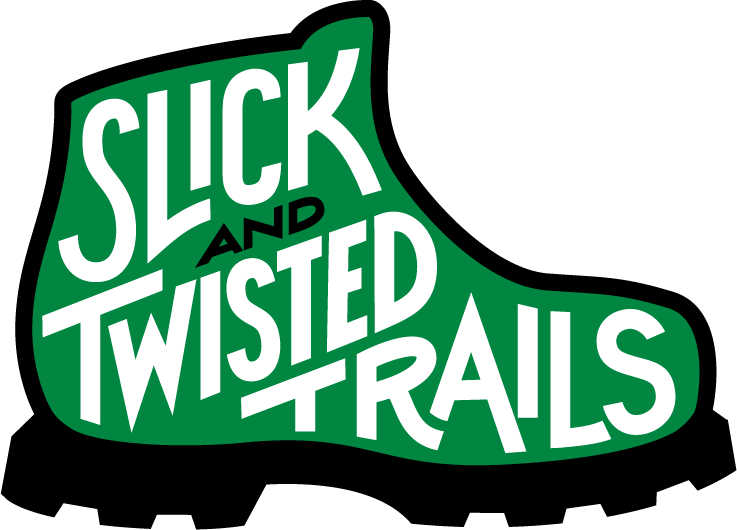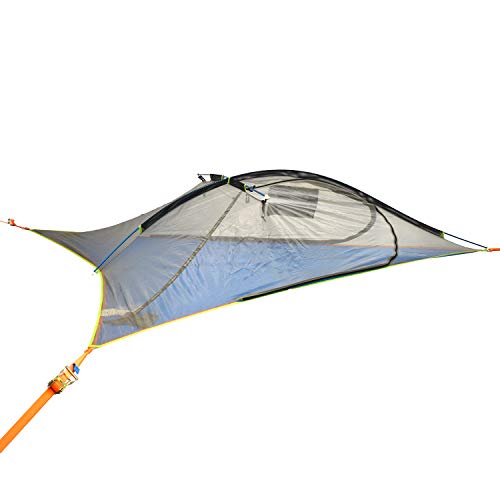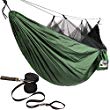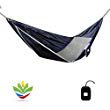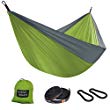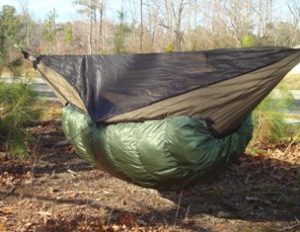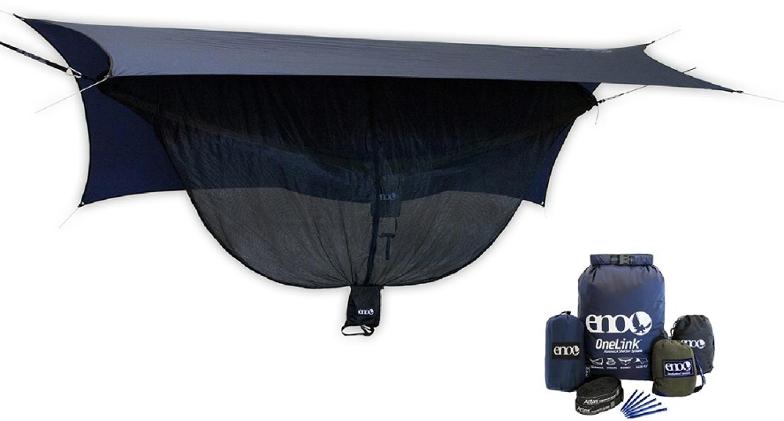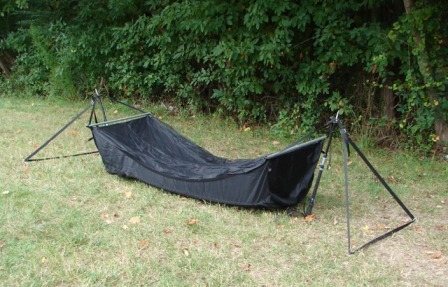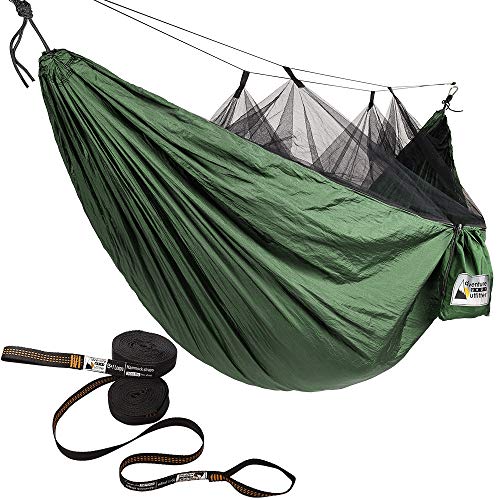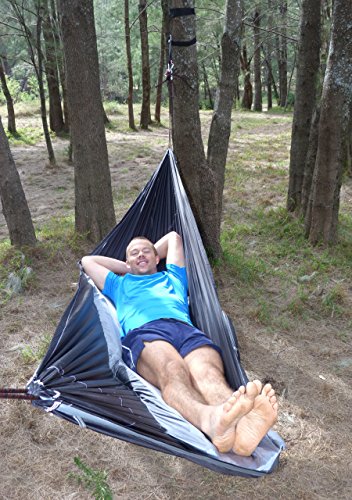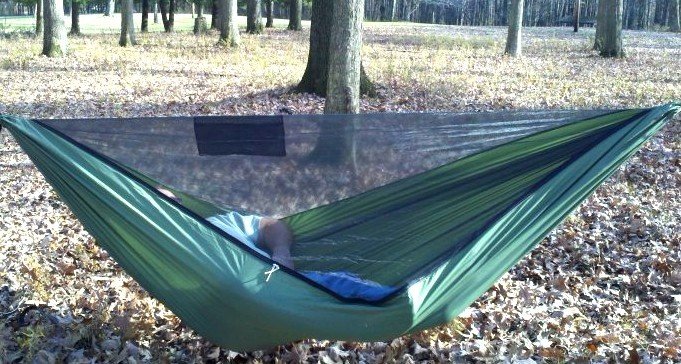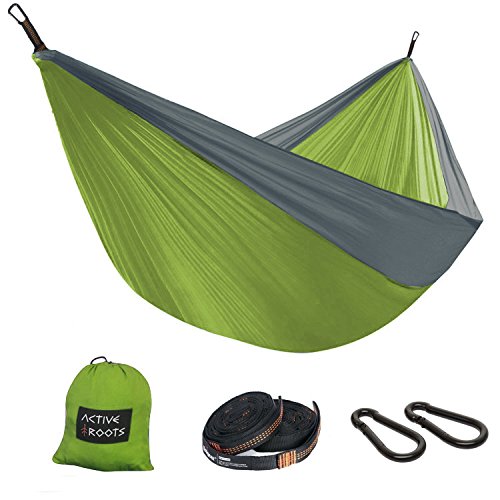Hammocks are an awesome summer accessory that many of us never look at as an option for backpacking. I hadn't even heard of them as backpacking shelters until the Trail Days celebration back in 2009 or so. That's when I bought my first backpacking hammock!
More...
Since then I've learned that they're fun, different, and helpful to many hikers who favor them over sleeping on the ground. It doesn't take long before you'll either fall in love with hammock camping or reject it entirely.
You're probably wondering how you can get started. What are the pros and cons of hammock camping? Which hammocks are the right ones for backpacking?
Don't worry I'm going to answer all those questions and more as we move forward!
To make your decision a bit easier, here are three categories of backpacking hammocks to consider (just click on the links to jump to each section):
Comparison Chart
Name | Weight | Length | Bug Net | Rain Tarp |
|---|---|---|---|---|
2.5 lbs | 115" | |||
3.3 lbs | 10' | |||
9.5 lbs | 10.6' | |||
4 lbs 3 oz | 9.5' | |||
2 lbs 4 oz | 10' | |||
4.8 oz | 10' | |||
3.75 lbs | 118" | |||
1.85 lbs | 9.5' | |||
1.6 lbs | 106.32" | |||
1.8 lbs | 125" | |||
16.59 oz | 11' | |||
2.3 lbs | 118" | |||
0.63 lbs | no info |
How to Choose a Hammock System
Before you even think about buying your first hammock, there’s a lot you need to know! Of course, if you want something to hang in the trees in your backyard any old piece of hanging fabric will do. However, in the world of hiking, camping, and backpacking hammocks it quickly gets more complicated.
Maybe more than other shelter systems, hammock systems are unfamiliar to most people. That means there’s a lot to figure out and a lot to potentially get wrong when choosing your hammock.
Be sure to read through the following sub-headings before you commit to buying your first hammock.
Hammock Underquilts
When temperatures drop and/or winds pick up, staying warm in a hammock becomes a problem. In tents the ground below you can suck heat away from you, but wind can't sneak between you and the earth.
In a hammock, you don't have to worry about the cold ground sucking away heat through conduction. Instead you have an even bigger problem - convective heat loss to a massive thermal sink called the air.
As cold air blows and circulates under you your body heat is rapidly stolen away and carried off. To prevent this you need a very insulating sleeping pad. Unfortunately, due to the shape and design of backpacking hammocks, a traditional foam or blow up pad won't work.
Traditional pads pinch, bind, slip, and just don't work in a hammock. I've tried it - it's not a solution.
You'll need an underquilt to solve this problem when temperatures drop below about 60 degrees at night.
Underquilts are the special backpacking hammock version of a sleeping pad. They're down-filled quilts that strap securely underneath your hammock.
My personal favorite underquilts are made by Under Ground Quilts from Jackson, MI.
If you're like me, you're probably doubting all this right now. You're saying, "Yeah, right. I sleep warm, I'll be fine with just using my mummy bag. I don't need to spend money on an underquilt."
Be my guest if you want to learn the hard way. I did. However, at some point, you'll realize that a hammock set up to use an underquilt is really necessary. That's why finding hammocks that are built to use an underquilt is a hugely important factor for 3-season hammocking.
Hammock Top Quilts
Yeah, unfortunately, there's still more to lean about hammock camping before we go any further. Now you know what an underquilt is, it's time to get acquainted with a top quilt.
Top quilts are just the top half of any sleeping bag. It's essentially a fancy down-filled nylon or polyester blanket for hammock campers.
Why don't hammock campers use mummy bags? Because then you end up having double insulation and weight underneath you. That means more to pack and more to carry. That's a no-no for backpackers.
When you sleep on a mummy bag you end up crushing all the insulation between you and the hammock. When insulation is crushed flat, it can't keep you warm. For that reason hammock campers use top quilts combined with an underquilt instead of mummy bags.
Because your underquilt is outside the hammock your body weight won't crush it flat. In that way a top quilt + underquilt combo is the only comfortable, real solution to the hammock campers paradox.
My favorite top quilts also happen to be made by Under Ground Quilts from Jackson, MI. You can order them custom or in-stock.
Hammock Insulation
One of the primary motivations of most hammock campers is to lighten up their sleep system. Hammocks offer a relatively lightweight alternative to many contemporary sleeping options.
In order to achieve this goal, most hammock quilts are made from high-quality lightweight down insulation. Other types of insulation are less commonly used because they’re relatively heavy and would cause hammocks and hammock sleep systems to weigh too much to be viable.
Down Insulation
Before you get into the world of down insulation, there’s a lot to know. Down insulation has a few pros and cons:
PROS
CONS
Because down insulation has such great insulation value per ounce of weight, it’s a fantastic material for quilts. However, these down feathers must be collected from live ducks and geese and it’s an expensive process that results in pricey quilts!
Down quilts also must be carefully stored when not in use. Down can be damaged by storing it (for long periods of time) in a packed or compressed manner. Therefore you’ll probably end up having a big down bag hanging from your closet.
Maybe the most vexing drawback of down insulation is that if (when) it gets wet the insulation itself loses most of its warmth. Comparatively, down insulation is much “colder” when wet than other modern synthetic insulation materials.
Hammock Ridgelines and Tree Straps
Hammock campers often get so picky about their hammocks that even the rope that the ridgeline is made from can matter a lot. While ridgeline material is important to some, the way that you tie off to the trees around you also plays an important role.
Ridgelines run the full length from one tree, through the hammock or tarp, and to the other tree or anchor. These are most often made from a material called Amsteel or Dynaglide in ultralight hammocks. You can get your own ridgeline materials to create or modify yours!
Many hammock users quickly find that they want a way to set and tension their hammock quickly. Tying knots and adjusting your hammock can be vexing for many hangers. Consider some of these various hammock tensioners from DutchWare Gear.
Note:
Often, generic hammocks can be made with unknown rope for ridgelines, guylines, etc.
Tree Straps, often called tree huggers, protect the tree from your hammock rope. These are usually made from some type of nylon webbing which you can use to make your own or buy premade hammock straps.
Hammock straps that come pre-sewn with adjustable lengths like these from ENO are probably the easiest to use but they’re relatively heavy. Maybe the strongest and lightest straps out there are from DutchWare Gear again.
Note:
Some areas require that hammocks use tree straps at least 1″ wide to protect trees.
Hammock Tarps
Asymmetrical hammock tarps are for asym-style hammocks. These are oblong and off-axis shaped tarps that provide more coverage in some areas than others. While they’re technically lighter than a “normal” square cut tarp, the skimping on coverage often makes setup hard and the threat of being soaked by wind-driven rain is real.
Square hammock tarps are usually actually rectangles. Now that’s out of the way, let’s talk pros and cons. Square tarps offer a lot more coverage and can be set up with a little more versatility than asym tarps. You’ll have to do the math yourself, but over the years I’ve come to feel that the 2-3 ounce weight savings of smaller tarps aren’t worth the tradeoff in space that a larger tarp can bring you. I opt for square tarps.
Integrated Hammock Tarp PSA: Hammock tarps should be tied to the trees with their own ridgeline – do not use the same line the hammock is on. Weight on the hammock will bring the two points on the hammock ridgeline together and your tarp will lose tension every time.
Consider running the ridgeline of your hammock tarp all the way through the tarp itself. This gives the tarp a solid line to fold over in the center and provides better pitches.
The Hidden Costs of Hammock Camping
Getting started hammock camping, as you may have guessed by now, ends up being a very expensive proposition for many backpackers. I found this out the hard way.
At first, the cost of a hammock itself seems reasonable. Then you realize you need an underquilt. Then, eventually, you upgrade your mummy bag to a top quilt. When it’s all said and done, it’s easy to blow $1,000 USD or more on a new lightweight hammock camping setup.
Before you start this journey, make sure to research your gear and find out if it’s in your budget.
Gathered End vs Spreader Bars
Gathered end hammocks and spreader bar hammocks spit the spectrum on suspension styles. What are the differences and benefits of each one?
Gathered end hammocks are simple, lightweight, and effective. Take a big, wide sheet of fabric, bunch up both ends, and tie those bunched ends to a rope and you’ve got a gathered end hammock.
Gathered end hammocks are simple and affordable to make. Simply gathering the fabric of the hammock is a great lightweight way to design a hammock. On the downside, however, the gathered end shape leads to a less flat lying position (think banana) in the hammock.
On the other end of the spectrum is the spreader bar. Spreader bars are used at the end of a hammock to hold the material flat and open. This results in a wider, flatter interior surface that’s a bit roomier and comfier for many folks.
The downside of a spreader bar, however, is the bar. This bar takes up space and adds weight in the pack.
Now, assuming that you aren’t concerned about being “ultralight” then a spreader bar hammock might be a great pick. Just remember that those bars are one more thing to carry, remember, and use.
How to Hang a Hammock
While there are many ways to hang a hammock, I’ll teach you what is probably the most common.
Today’s hammock hanging methods are, fortunately, smarter and more ecologically friendly than those of yesteryear. To prevent tree damage most people use (and some parks require) 1” wide tree straps at a minimum.
I have to reinforce the importance of these 1” straps. These straps spread out the force of your hang across the bark of your chosen trees. This helps prevent visual impacts (worn bark) and environmental damage both - which is important to the trees and other park visitors.
It’s worth noting that hammock straps are not created equal. Many hammock straps are over built. This isn’t a bad thing, but if ultralight is your game then make sure you go for the lightest weight straps that will still hold your hammock. On the same note, the quick adjust (multi-loop) hammock straps are also heavier than single loop straps.
Generally, adjustable ridgeline systems are lighter weight than adjustable straps. A ridgeline system such as the popular Whoopie Slings are super light and adjustable.
Once you’ve chosen your trees, set up your straps, and deployed your whoopie slings all that’s left is to perfect the hang.
Getting the right hang is important to make sure you’re comfortable and that your gear is used properly. Check out this video for a little more insight.
Hammocks that double as tents
One of the largest drawbacks to hammock hiking is that not all trails have available trees to hang your shelter from. Manufacturers have realized this hindrance and their response has been to create hammocks that can double as a tent by being staked down to the ground. Makes sense, right?
That said, the extra features result in a hammock that is much heavier and bulkier to carry than other models. For some hikers, these double-duty hammocks are a great example of a piece of gear that attempts to be a multi-tool but does neither of its jobs perfectly.
Want a hammock for a lazy afternoon? Need a hammock that can keep the bugs out? What about a hammock that can be used as an emergency tent if there’s nowhere to hang it?
At a price that really can’t be beat, the Etrol Hammock mimics the popular spreader bar design with a couple changes.
Instead of a spreader bar, it’s technically a gathered end. At the head and feet, however, is an arched bar like a tent pole. This helps keep the hammock and bug net opened up despite being a gathered end hammock.
Another big advantage of this design is that it can be used on the ground as a tent when needed. Of course the drawback is that you need to carry the poles but most people won’t mind that.
INFO | DATA |
|---|---|
Total Pack Weight | 2.5 lbs |
Extended Size | 55" x 115" |
Bug Net | |
Rain Fly | |
Suspension System Incl. |
Coming in at under $100, this hybrid hammock/tent system is the more budget-friendly model. Two arch poles are used to hoist the bugnet and act as the skeleton for the waterproof rainfly. All the ropes and tie downs required to hang this product are included, making the entire package ready to go.
This system features single-point anchors at the head and feet, resembling more of a hammock than a tent. The rainfly and arch support system are clunkier than some other models, but it can still be used as a tent in situations where trees are not available.
Budget friendly with a get the job done attitude, the Patent Camping Hammock is another model in the hybrid hammock line.
INFO | DATA |
|---|---|
Total Pack Weight | 3.5lbs |
Pack Size | 12 x 7 inches |
Bug Net | |
Rain Fly | |
Suspension System Incl. |
Is it a tent? Is it a hammock? Is it a floating tent? These hanging tent hammocks have gained popularity recently and I think it’s time one made the list.
Unlike other hammocks on our list this one is a two-person. So remember that the packed weight can be divided by two once you split up the weight. That said, it’s far from ultralight (just south of 10 pounds) no matter how you crunch the numbers.
While it may not be the lightest option, it might be the most interesting. Using 3 super-strong ratchet straps the whole hammock/tent suspends off the ground in a flat orientation. Meanwhile, tent poles and a rainfly finish off this shelter just like your standard tent.
If you want a novel way to camp and sleep then check this out.
INFO | DATA |
|---|---|
Total Pack Weight | 9.5 lbs |
Pack Size | 17.7 x 10.6 x 8.2 inches |
Bug Net | |
Rain Fly | |
Suspension System Incl. |
Complete Sleep System Hammocks
These hammocks do not double as tents but usually include a rain fly and a bug net. More popular with thru-hikers who care about weight and comfort, the models here are excellent choices for backpacking.
I started with one of these hammock systems but rapidly found that through modification and replacement I made my own hammock system. For inexperienced hammock campers, these complete systems are a good place to start.
This hammock is designed to be used in the most rugged of situations. Unapologetic in the quality of material used, the user does not have to worry about this model breaking or wearing out during the longest of long distance hiking.
Able to fit two people up to 400lbs, the high strength nylon can be folded into the size of a grapefruit. The bug net and rainfly are both detachable and the hammock is equally at home on the beach or backyard as it is in the backcountry.
The suspension system offers 30 points of contacts, making hanging this product incredible easy to customize, fitting every situation imaginable. Everything needed for hanging the ENO OneLink Hammock fits into the included stuff sack, ensuring nothing gets left at home
INFO | DATA |
|---|---|
Total Pack Weight | 4 lbs 3 oz |
Pack Size | 11 x 10 x 4.5 inches |
Bug Net | |
Rain Fly | |
Suspension System Incl. |
When I started hammocking on my backpacking trips I used the Hennesy Hammock Hyperlight. To this day I still use a modified version of this hammock when I choose to take a hammock on my backpacking trips!
The asymmetric design of the hammock and rain fly conforms better to the human shape than a simple banana shape. When sleeping in asymmetrical hammocks, you actually sleep diagonally across the hammock. This makes the lay of the hammock almost flat instead of banana shaped.
Meanwhile you retain the lightweight benefits of a gathered end hammock. You do need to be careful as the maximum weight capacity of this hammock is about 250 pounds including any gear stored in the hammock. Exceeding this weight capacity can result in a destroyed hammock.
From first hand experience I can say that this hammock can be altered to weigh substantially less than the 36-ounce manufacturer weight with a few DIY alterations.
INFO | DATA |
|---|---|
Total Pack Weight | 2 lbs 4 oz |
Pack Size | 4" x 8" x 10" |
Bug Net | |
Rain Fly | |
Suspension System Incl. |
Ready for a bridge hammock system that will blow your mind?
The Jacks R Better Complete 3 Season Special is a hammock kit designed to get you on the trail with everything you need. Yeah, the price tag is steep but it’s cheaper and easier than buying each piece of gear from different makers!
This kit includes:
- Bridge Hammock
- Rain Fly
- Suspension
- Top Quilt
- Underquilt
- Stakes
At a total weight of 6 pounds 2 ounces you’ll be ready to hit the trail with a complete sleep system at just over 6 pounds.
This should blow your mind when you remember that the Blue Ridge Camping Hammock by Lawson (also a bridge style) which we reviewed earlier weighed in at 4.25 pounds just for the hammock.
This hammock camping system is proven, reliable, and well crafted by a reputable manufacturer. You won’t get started hammock camping any easier or better than this.
INFO | DATA |
|---|---|
Total Pack Weight | 4.8 oz |
Pack Size | 10' |
Bug Net | |
Rain Fly | |
Suspension System Incl. |
If you’re on a budget but you still want a hammock that will keep off the bugs and rain, here we are! While the Easthills hammock might not be an ultra-performer it’s certainly a budget pick and we know that matters to many of you.
This gathered end hammock is made from 210T nylon and rated for up to 700 pounds. Since the hammock is rated for two people just be sure that your combined weight is reasonably within the limits of the hammock.
That said, there’s a full bug net and generous tarp (10’x10’) big enough to fit both occupants should you choose to double up.
Just remember that what you save in price you pay for in weight. The combined tarp (24 oz) and hammock (36 oz) tip the scales at 3.75 pounds. Remember, you’ll still need an under quilt and top quilt at the very least to pair up with this kit.
INFO | DATA |
|---|---|
Total Pack Weight | 3.75 lbs |
Pack Size | 14.4 x 10.5 x 6 inches |
Bug Net | |
Rain Fly | |
Suspension System Incl. |
Basic Bug Net Hammocks
Hammocks in this category come with a bugnet but not a rainfly. Perfect for those who prefer to invest in a high quality rainfly or like to sleep under the stars.
This hammock is built for serious backpackers in mind. Created without extras, and only featuring a bugnet, this hammock is lightweight and designed for adventure.
The mosquito net is made with elastic around the anchor points to prevent tearing and increase the lifetime of the net. I am impressed with this ingenuity because constant packing and unpacking will tear holes in mosquito netting. So it’s a smart idea.
INFO | DATA |
|---|---|
Total Pack Weight | 1.85 lbs |
Pack Size | 9.8 x 6 x 4.5 inches |
Bug Net | |
Rain Fly | |
Suspension System Incl. |
Affordable? Keeps the bugs off? Lets you enjoy a hang? Yes to all of the above!
At just 1.6 pounds this hammock rocks a high 440 lbs weight limit. That’s really darn good for the price tag associated with this hammock!
Even though you won’t pay much for this hammock, it does have everything you need. Tree straps, net ropes and hooks, steel carabiners and a carrying bag are ready to go.
In my world this is a top contender for occasional use, camping, keeping bugs off, or giving the kids something to hang in. Of course, you probably could pair this with any lightweight tarp and it might just make a decent lightweight entry backpacking hammock at an absurdly good price.
INFO | DATA |
|---|---|
Total Pack Weight | 1.6 lbs |
Pack Size | no info |
Bug Net | |
Rain Fly | |
Suspension System Incl. |
This hammock is designed for maximum comfort. Its assymetrical lay out boasts a flat sleeping area, even with the bunched end anchor points. A very cool feature is a nylon sleeve that most sleeping pads can slide into, preventing any slippage.
The bug net has 2100 holes per square inch, making the mesh extremely fine, guaranteeing a bug free night, wherever you’re camped.
INFO | DATA |
|---|---|
Total Pack Weight | 1.8lb (.82kg) |
Pack Size | 7.4 x 10 x 5.5 inches |
Bug Net | |
Rain Fly | |
Suspension System Incl. |
Ultralight Hammocks
Ultralight hammocks spare no expense in search of the lightest possible piece of gear you can carry to sleep in a tree. Like most ultralight gear, you'll have to master your skills and knowledge of hammock camping to effectively use these.
Many of these ultralight models will need a separate rain fly. Some may need optional bug nets if your situation calls for it.
While it might seem like a hassle to deal with, choosing each piece of gear separately means you can tailor your setup perfectly for you.
At just 16.59 ounces in its smallest configuration, the Darien hammock by Dream Hammock is one of the lightest hammock+bug net combinations available today.
Unlike other ultralight hammocks from places like Amazon you can actually customize the length, width, and fabric material of this hammock. Depending on your choices, the Darien can accommodate almost any height and weight of user.
Of course, each different combination of options will result in a different finished weight.
Once you pick up this hammock you’ll need to choose a hammock tarp. Snag a Sil Poly Hanger Tarp from Underground Quilts to round out your hammock setup!
If I was building a new hammock camping setup, I would start with this hammock personally.
The asymmetrical lay of this hammock makes it the most ideal customizable hammock on the market for ultralight hikers right now, in my opinion.
INFO | DATA |
|---|---|
Total Pack Weight | 16.59oz (0.47kg) |
Pack Size | Stuffed |
Bug Net | |
Rain Fly | |
Suspension System Incl. |
Note that the Active Roots hammock was sent to me for testing.
200T Nylon provides the body of this hammock with plenty of strength. It’s rated for ~500 pounds of support which is more than 2x as much load as others like the Hennessy Hammock Hyperlight on our list.
The material is lightweight but strong and most hikers will find this hammock entirely ample for their purposes. Plus, it’s very affordable compared to other ultralight hammocks.
But at just under 2 pounds for the whole system, it’s really more ‘lightweight’ than ‘ultralight’. However, the suspension strap can easily be swapped with Dynaglide Whoopie Slings and the carabiners can be removed altogether. This would bring the total weight down to near 1 pound with modifications.
I do like the stock suspension system which resembles the popular ENO slings. There are sewn webbing loops every few inches that can quickly and easily be adjusted with a clip of the carabiner.
I should mention that the hammock itself is very deep and expansive with enough room for two people. It makes a good backyard hammock that is extremely comfortable when not in use on the trail.
Note that this hammock is not an asymmetrical lay which means you’ll be sleeping in a banana shape all night. It is, however, wide enough to adapt yourself to something close to asymmetrical so for some folks this may be just fine.
INFO | DATA |
|---|---|
Total Pack Weight | 2lbs (0.9kg) |
Pack Size | 7x 4.5x 4.5 inches |
Bug Net | |
Rain Fly | |
Suspension System Incl. |
Small, lightweight, and simple: this product is built for those hammock-loving hikers who always need to carry one. Made with ripstop nylon Gravitas fabric, the material resists tearing and is reinforced at the anchor points.
Incredibly lightweight and packable, many will be tempted to carry it just because of its small size.
No bug net or rainfly comes with this tent but straps and carabiners are included. Simple and straightforward, the Kammok Wallaby can double as a day-tripper as well as an overnight sleep system.
I would heavily consider this hammock as the basis for an ultralight system. However, it is not an asymmetrical lay which means you’ll be crunched in a banana shape all night.
Because of the short length and lack of asymmetry many folks may find a major trade off of comfort for lightweight on this hammock. The choice, as always, is yours to make.
INFO | DATA |
|---|---|
Total Pack Weight | .63lb (.29kg) |
Pack Size | 4.5 x 3.5 inches |
Bug Net | |
Rain Fly | |
Suspension System Incl. |
Choosing the right model for you
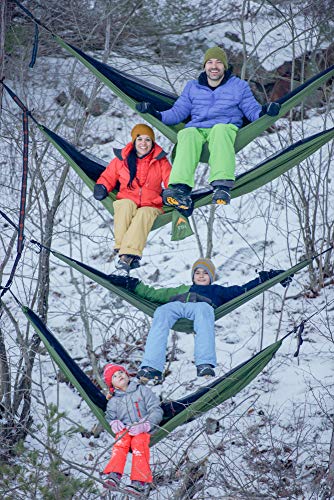
With camping hammocks, perhaps more than any other camping system, there is a lot to learn. They’re different from the styles and gear used for tents and tarps. You need to learn and master completely different skill-sets to become proficient at hammock camping.
For many, hammocks are a lightweight method of camping without sleeping on the ground. If you want the lightest possible system, you’re going to have to spend top dollar, do tons of homework, and combine gear from different makers.
Often, this process involves modifying or creating parts of the gear yourself.
Many hikers don’t want that hassle. If you don’t mind carrying a few extra ounces, you can get started with a complete hammock system like the one we reviewed from Jacks R Better.
Remember that a backpacking hammock needs completely different materials and construction than backyard hammocks. Not every hammock is suited to being a camping hammock.
While you may be tempted to save a buck and use the cheapest hammock you can find, be sure to look at it with a critical eye. Many cheaper hammocks are better suited to backyard barbecues than backpacking.
Just keep in mind that you may need to radically update your gear to get the most out of hammock camping. You might need a new top quilt, underquilt, and tarp to add to your hammock.
Of course, the savvy backpacker probably already uses a top quilt and a tarp anyways and can adapt to a hammock by only having to purchase an underquilt, so consider yourself lucky if you’re in this category!
Article Update: 2018
This article was updated on 3.19.2018 to include the latest gear and information by Casey Fiedler. Some content from the original work of Joel Salvino has been altered or updated.
